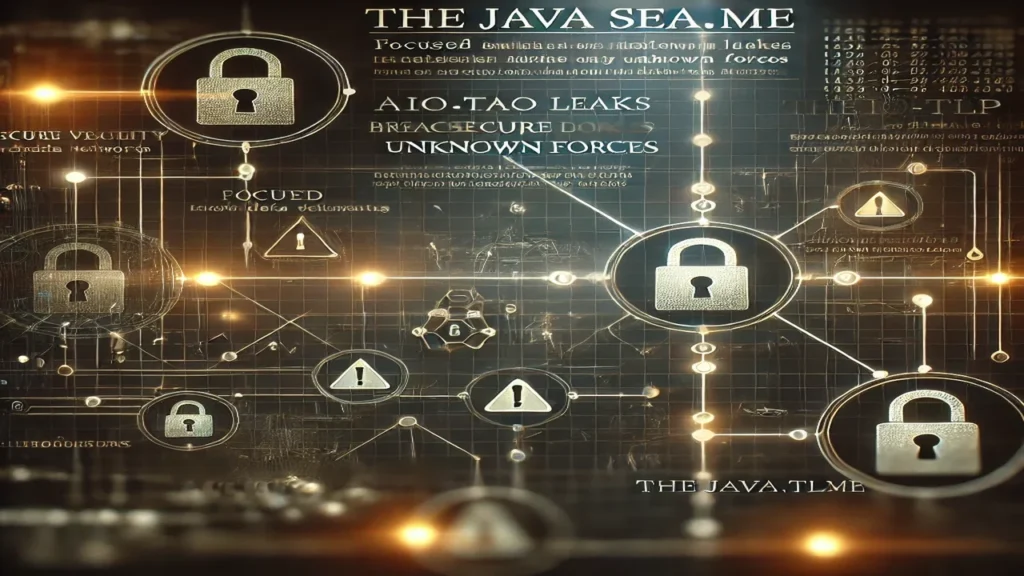Cybersecurity is critical in today’s linked world because data breaches can have catastrophic effects. Cybersecurity professionals are paying close attention to the recent TheJavaSea.me leaks AIO-TLP incident. When it comes to managing and responding to cyber threats, professionals rely on AIO-TLP, which stands for All-In-One Threat Intelligence Platform. People are very worried about the safety and reliability of these systems after sensitive information leaked from this platform.
This article explores the TheJavaSea.me leaks AIO-TLP incident, looking at the consequences for companies, the effect on security protocols, and how future threats might be prevented. This article will walk you through every aspect of the breach, what it means, and what you can do to safeguard your digital assets.
What Is TheJavaSea.me?

Examining the platform in question is essential for comprehending the gravity of the TheJavaSea.me leaks AIO-TLP incident. Popular online community hub TheJavaSea.me also became a safe haven for private data associated with cybersecurity solutions like AIO-TLP.
The Importance of AIO-TLP in Cybersecurity
When it comes to identifying and controlling cyber dangers, AIO-TLP (All-In-One Threat Intelligence Platform) is indispensable. It aids cybersecurity experts in responding to threats by classifying them using a colour-coded system. Here are the categories:
- Red: Restricted information
- Amber: Very little information sharing between companies
- Green: Data that can be exchanged with business associates
- White: Public data
By offering a structure for efficiently managing threat intelligence, AIO-TLP aids organisations in improving their security protocols. Unfortunately, a plethora of sensitive information was made public after this system breach.
| Category | Description | Key Benefits | Statistical Insights |
|---|---|---|---|
| Red | Restricted information, limited to essential personnel due to high sensitivity. | Prevents unauthorized disclosure, ensuring privacy and security in high-stakes situations. | 62% of cyber incidents are mitigated effectively when critical information is restricted to necessary personnel only. |
| Amber | Information shared within the organization or trusted partners with limited exposure. | Enhances trust and security, preventing data exposure beyond trusted circles. | Organizations using Amber-level protocols see a 35% decrease in internal data breaches. |
| Green | Information that can be shared within the community to enhance collective security. | Fosters a collaborative security environment, building a strong community defense. | Community-sharing systems reduce individual organization’s response time to threats by up to 40%. |
| White | Publicly accessible data, posing no significant risk if shared widely. | Increases transparency and helps inform the public and external stakeholders. | 80% of organizations report improved public trust when white data is used to communicate security measures. |
The Effects of the TheJavaSea.me AIO-TLP Security Breach

The disclosure of sensitive information, especially that pertaining to a vital tool like AIO-TLP, can have far-reaching effects. What follows is an examination of the leak’s more general effects on companies and cybersecurity.
What Data Was Exposed?
Highly sensitive information was leaked in the AIO-TLP incident at TheJavaSea.me. Supposedly, the compromised information comprises:
- Numbers assigned to computers: Cybercriminals can initiate targeted attacks by utilising these.
- Login information: Intruders could gain access to systems if they were able to access accounts.
- Classifications of threats: It would be helpful for attackers to know how organisations classify threats so they can prioritise their targets.
- Due to the fact that attackers now have access to information that allows them to bypass security defences, the AIO-TLP framework is now compromised.
How Did the Breach Occur?
Cybersecurity professionals think that hackers were able to access sensitive information through unauthorised access to TheJavaSea.me, although the specifics of the breach are still unknown. Possible causes of the breach include inadequate encryption, unreliable access controls, or irregular security audits. This highlights the necessity to strengthen internal security measures and the significance of constant monitoring.
The Ripple Effect on Affected Companies
Businesses that depend on AIO-TLP are now at danger of having their threat intelligence turned against them. The information could be used by attackers to create more advanced attacks. In addition to causing financial losses and legal ramifications, the leak damages companies’ reputations.
Legal Ramifications of the AIO-TLP Leak

There is a growing complexity in the legal landscape as it pertains to data leaks. Legal ramifications for TheJavaSea.me could be substantial in light of data protection regulations like the GDPR and the CCPA in California. Businesses impacted by the breach may seek legal recourse to recoup losses, and regulatory agencies may impose heavy fines.
Rebuilding Trust After a Breach
Restoring confidence is of the utmost importance following a leak of this magnitude. Companies in this situation need to move quickly to reassure their stakeholders and customers that they are taking steps to improve security. Making the organisation more transparent and holding employees accountable are crucial steps in regaining trust in their data security measures.
How to Protect Against Future Leaks
Cyberattacks can affect even the most reliable platforms, as the TheJavaSea.me leaks AIO-TLP incident demonstrated. Organisations can take practical measures to protect their systems and avoid future breaches by reading this.
Strengthening Encryption Standards
This case of TheJavaSea.me leaks AIO-TLP may have been susceptible to weak encryption, among other vulnerabilities. Protect sensitive data while it is in transit or at rest by using a strong encryption standard like AES-256. Encryption is a useful tool for making data unintelligible in the event of interception.
Implementing Multi-Factor Authentication
Concerns about password security have led many to advocate for multi-factor authentication (MFA) as a means to significantly lessen the likelihood of unwanted access. Businesses can increase the difficulty of attackers gaining access to sensitive systems by implementing multiple forms of verification.
Regular Security Audits
If you want to find security holes before an attacker finds them, you need to conduct security audits often. To guarantee that security protocols are current, a thorough audit should incorporate scanning for vulnerabilities, conducting penetration tests, and reviewing policies.
Continuous Monitoring and Incident Response
To keep one step ahead of potential breaches, continuous monitoring is essential, as cyber threats are always evolving. Businesses can be better prepared to respond swiftly to security breaches by utilising automated systems that can identify suspicious activity and initiate incident response protocols.
Employee Training and Awareness
One of the major threats to cybersecurity is human mistake. Staff members should participate in ongoing security awareness training to learn about new risks and how to best secure sensitive information.
What Are the Security Risks of the AIO-TLP Leak on TheJavaSea.me?

Many risks, including those with potential long-term effects, are exposed to firms by the AIO-TLP leak.
Increased Vulnerability to Targeted Attacks
Organisations are more vulnerable to targeted attacks now that cybercriminals have access to detailed threat classifications. This data can be used by attackers to target specific security holes, making breaches more likely.
Financial Loss and Reputational Damage
Companies relying on AIO-TLP for threat intelligence management could suffer heavy financial losses as a result of the leak. It could take years for the company’s reputation to recover from the damage that could occur if customers and partners lose faith in its ability to secure sensitive data.
Legal and Regulatory Scrutiny
Companies that did not adequately secure their customers’ personal information and were impacted by the AIO-TLP leak may be subject to legal action. Companies may face even more financial difficulties if regulatory agencies fine them or if impacted individuals sue them.
Frequently Asked Questions
1. What is the AIO-TLP leak on TheJavaSea.me?
The TheJavaSea.me leaks AIO-TLP incident involves the unauthorized exposure of sensitive data related to the All-In-One Threat Intelligence Platform. This platform is used by cybersecurity professionals to manage and respond to threats.
2. How did the leak affect businesses?
The leak has compromised the threat intelligence of several businesses, increasing their vulnerability to cyberattacks. Sensitive data, including IP addresses and user credentials, were exposed, making organizations more susceptible to targeted attacks.
3. What steps can businesses take to protect themselves?
Businesses should strengthen encryption, implement multi-factor authentication, and conduct regular security audits. Employee training and continuous monitoring are also essential for safeguarding against future breaches.
4. What are the potential legal consequences?
Companies affected by the AIO-TLP leak could face fines from regulatory bodies under data protection laws such as GDPR or CCPA. Legal action may also be taken by affected individuals or organizations.
Also Read: Netwyman Blogs: All About Networking, Technology, and Related Subjects
Conclusion
No platform is safe from cyberattacks; the TheJavaSea.me leaks AIO-TLP incident is proof of that. Securing systems, strengthening encryption, and protecting sensitive data should be top priorities for businesses. Organisations can lessen their risk and strengthen the protection of their digital assets against future threats by establishing strong security protocols and encouraging a culture of cybersecurity awareness.

Deloris Scott is a talented blogger at Explainervilla.com, writing about a variety of topics, including technology and culture. She focuses on how modern life connects with long-standing traditions and explains the newest innovations and sustainability efforts in simple terms.
